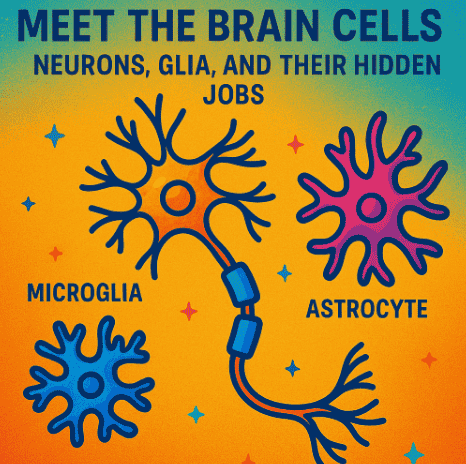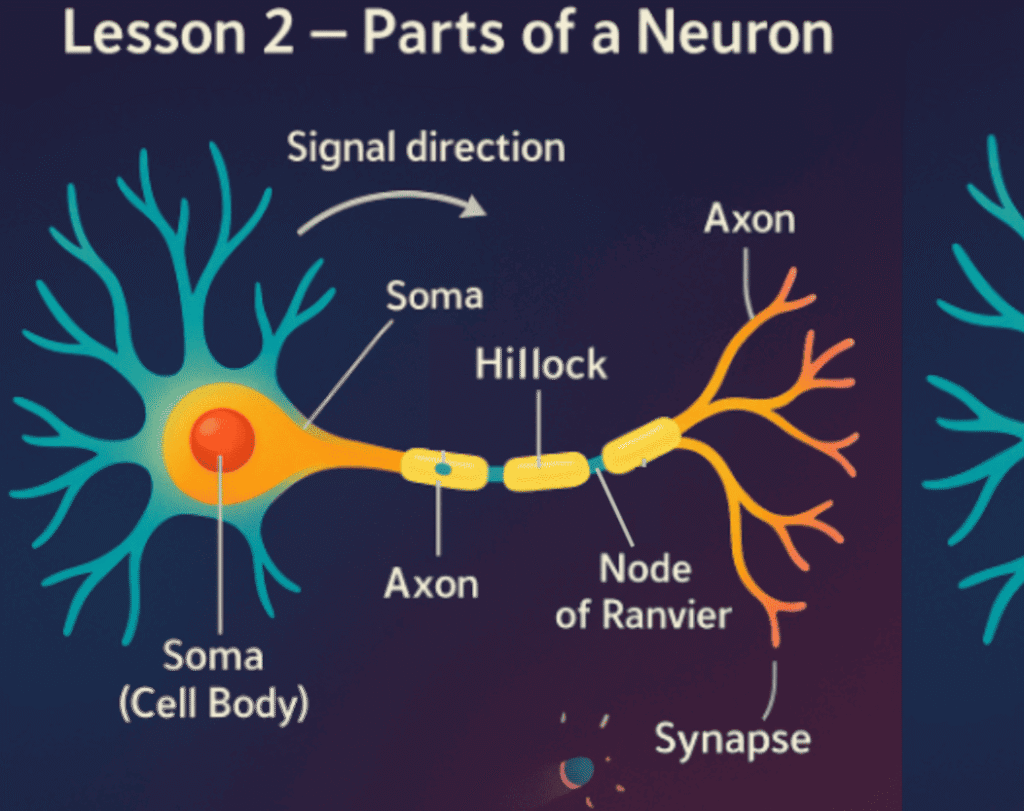
Recap of Lesson 1
In Lesson 1, we explored the brain as a whole — the “puppet master” that controls every thought, movement, and feeling. We learned:
-
The brain is soft, wrinkly, and weighs about 1.3–1.4 kg.
-
It has three main parts: the brainstem (survival), the limbic system (emotions), and the cortex (thinking).
-
It never rests, running everything from heartbeat to imagination.
Now, we zoom in closer — to the tiny workers that actually make the brain function. These are the brain cells.
Section 1: What Are Brain Cells?
Your brain is made up of around 86 billion brain cells 😲. That’s more than the number of stars you can see on a clear night.
These cells are mainly of two types:
-
Neurons – the famous “nerve cells” that send signals. They are like the electric wires of the brain.
-
Glia – the “helper cells” that protect, feed, and support the neurons. They are like the caretakers and support staff of the brain.
For a long time, scientists thought neurons were the “stars” 🌟 and glia were just boring glue (in fact, glia comes from the Greek word for “glue”). But today we know glia are just as important — without them, neurons cannot survive.
So if the brain is a city:
-
Neurons are the citizens (they communicate, work, and exchange ideas).
-
Glia are the builders, cleaners, and police (they keep everything running smoothly).
Section 2: Neurons – The Brain’s Messengers
A neuron is a special cell that can send and receive messages. It works like a living wire that uses both electric sparks ⚡ and chemical signals 💧.

Structure of a Neuron
Imagine a tree 🌳:
-
The dendrites are the branches — they receive incoming signals.
-
The cell body (soma) is the trunk — it holds the nucleus (the control center of the cell).
-
The axon is the long cable-like root — it carries the signal away.
-
The axon terminals are the root tips — they release the signal to the next neuron.
A neuron is tiny, but some axons can be over 1 meter long (for example, the ones running down your spine to your legs). That means one cell can stretch from your back to your toes!
How Many Neurons Do We Have?
Humans have about 86 billion neurons. Each can connect with up to 10,000 other neurons, making trillions of connections. These connections are called synapses.
This is why your brain is much more powerful than any computer — the sheer number of connections.
Section 3: Glia – The Unsung Heroes
Glia don’t send signals like neurons, but they do everything else that keeps the brain alive. There are several types of glia:
-
Astrocytes ⭐ – Star-shaped cells that feed neurons, clean up waste, and even help with learning.
-
Oligodendrocytes 🧥 – They wrap axons with a fatty layer called myelin, which speeds up signals. Think of myelin as insulation on electrical wires.
-
Microglia 🧹 – The brain’s immune cells. They fight germs, clear dead cells, and protect the brain from damage.
-
Schwann Cells – Similar to oligodendrocytes, but in the peripheral nervous system (outside the brain and spinal cord).
Without glia, neurons would starve, slow down, or die.
Section 4: How Neurons and Glia Work Together
Imagine a busy railway station 🚉:
-
Neurons are the trains, carrying passengers (signals).
-
Glia are the staff — the cleaners, engineers, guards, and repair crews that keep the trains running.
If neurons fail, no messages get across.
If glia fail, neurons collapse.
The two are inseparable.
Section 5: The Amazing Speed of Neurons
Neurons send signals at speeds from 1 meter per second (slow) to 120 meters per second (fast). That’s faster than a racing car 🚗💨.
Example: If you touch a hot stove 🔥, your neurons send a “pain” message to the brain almost instantly, and another signal rushes back to move your hand away.
This super-fast communication is why you can react so quickly to danger.
Section 6: How Neurons Create the Mind
One neuron alone is not very powerful. But when billions of them connect, they form networks.
-
A network in the visual cortex lets you recognize faces 👀.
-
A network in the auditory cortex lets you understand music 🎶.
-
A network in the hippocampus helps you form memories 🧳.
The “mind” — your thoughts, feelings, identity — is not in one single neuron. It is in the patterns of firing across networks.
So the mind is like a symphony 🎼 — each instrument (neuron) plays a small part, but together they create music.
Section 7: Why Studying Brain Cells Matters
Understanding neurons and glia helps us fight diseases:
-
Multiple sclerosis happens when myelin (the insulation) is destroyed.
-
Alzheimer’s disease happens when neurons and glia malfunction, causing memory loss.
-
Parkinson’s disease happens when certain neurons die, leading to movement problems.
It also helps us build artificial intelligence (AI) — computers inspired by how neurons connect.
Section 8: The Big Picture
We now know:
-
The brain is built from two main types of cells: neurons and glia.
-
Neurons send signals like wires; glia support, protect, and speed up the process.
-
Together, they create complex networks that give rise to thought, memory, and identity.
Next lesson, we’ll zoom in even further: How Neurons Talk – Electrical Sparks and Chemical Signals.